Strategic Change Management and Organisational Development at LPHY
VerifiedAdded on 2023/06/10
|10
|2337
|400
Report
AI Summary
This report provides an analysis of change management and organisational development within LPHY, a local charity organisation supporting a hospice. It identifies strategic changes LPHY can undertake, such as restructuring terms and conditions and improving HR policies. The report uses Lewin's change management model to outline a planned approach, focusing on unfreezing, changing, and refreezing stages. It also addresses potential organisational and individual resistance to proposed changes, suggesting strategies for effective recruitment, training, and technology adoption. The report concludes that implementing these changes is crucial for LPHY to adapt to the dynamic business environment, improve efficiency, and achieve its goals. Desklib offers a variety of similar assignments and study resources for students.
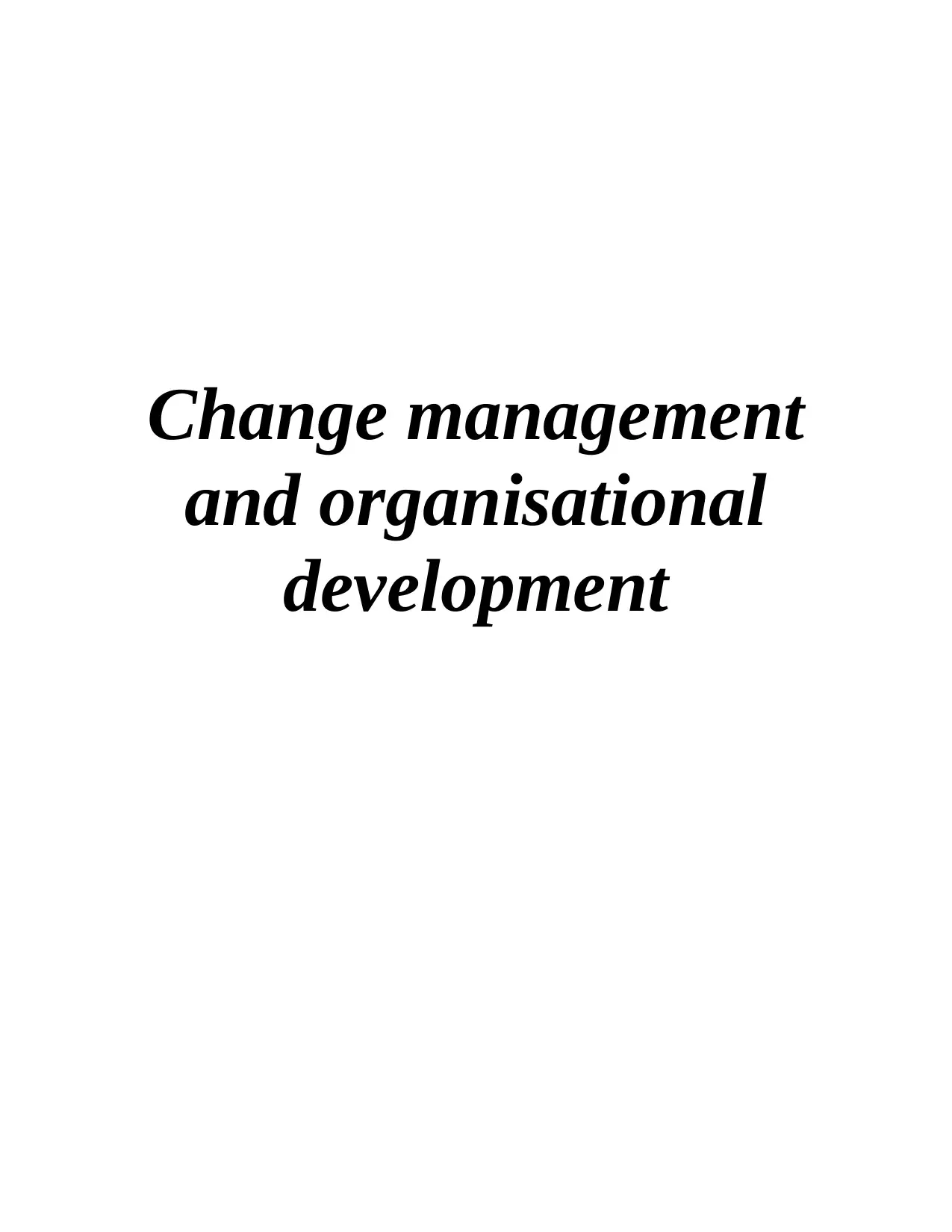
Change management
and organisational
development
and organisational
development
Paraphrase This Document
Need a fresh take? Get an instant paraphrase of this document with our AI Paraphraser
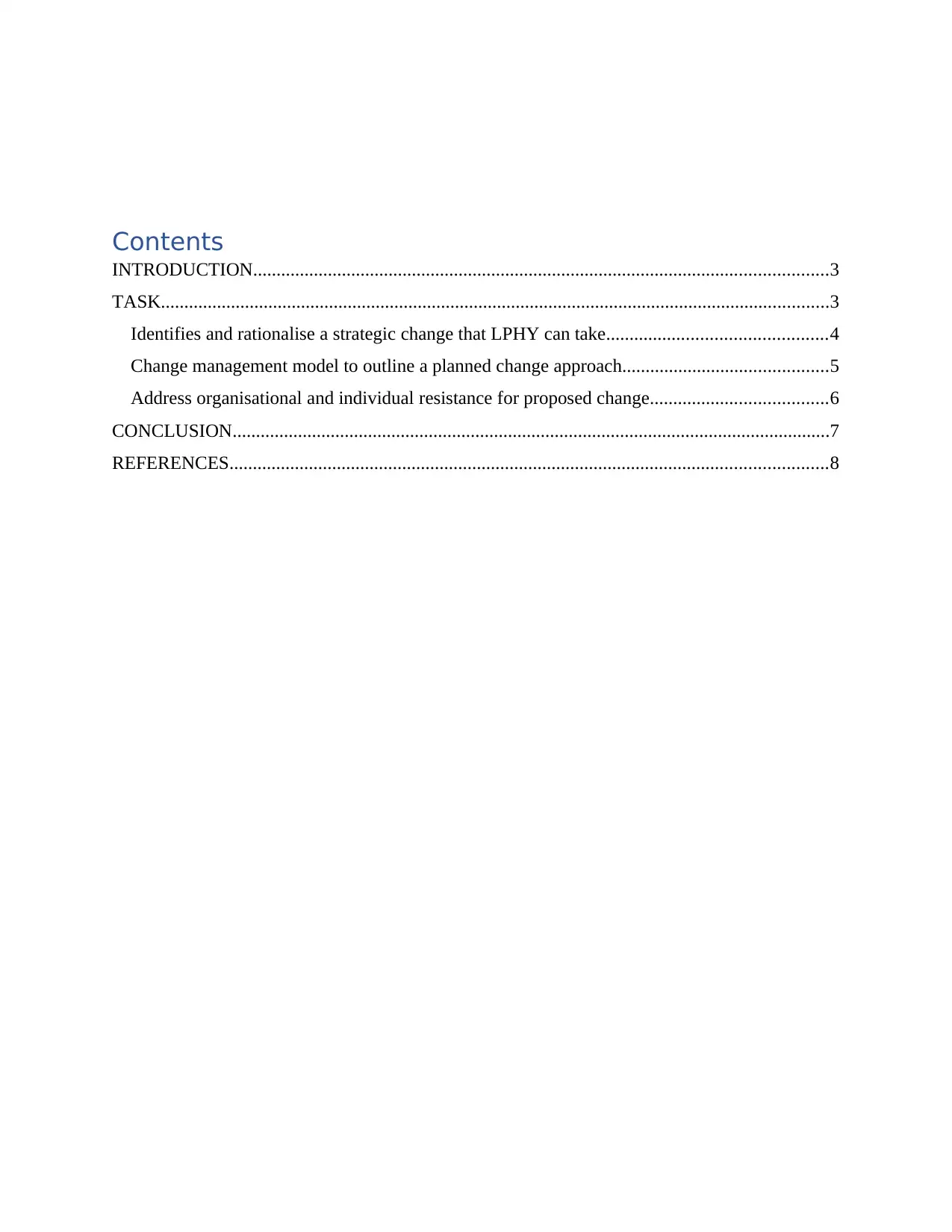
Contents
INTRODUCTION...........................................................................................................................3
TASK...............................................................................................................................................3
Identifies and rationalise a strategic change that LPHY can take...............................................4
Change management model to outline a planned change approach............................................5
Address organisational and individual resistance for proposed change......................................6
CONCLUSION................................................................................................................................7
REFERENCES................................................................................................................................8
INTRODUCTION...........................................................................................................................3
TASK...............................................................................................................................................3
Identifies and rationalise a strategic change that LPHY can take...............................................4
Change management model to outline a planned change approach............................................5
Address organisational and individual resistance for proposed change......................................6
CONCLUSION................................................................................................................................7
REFERENCES................................................................................................................................8
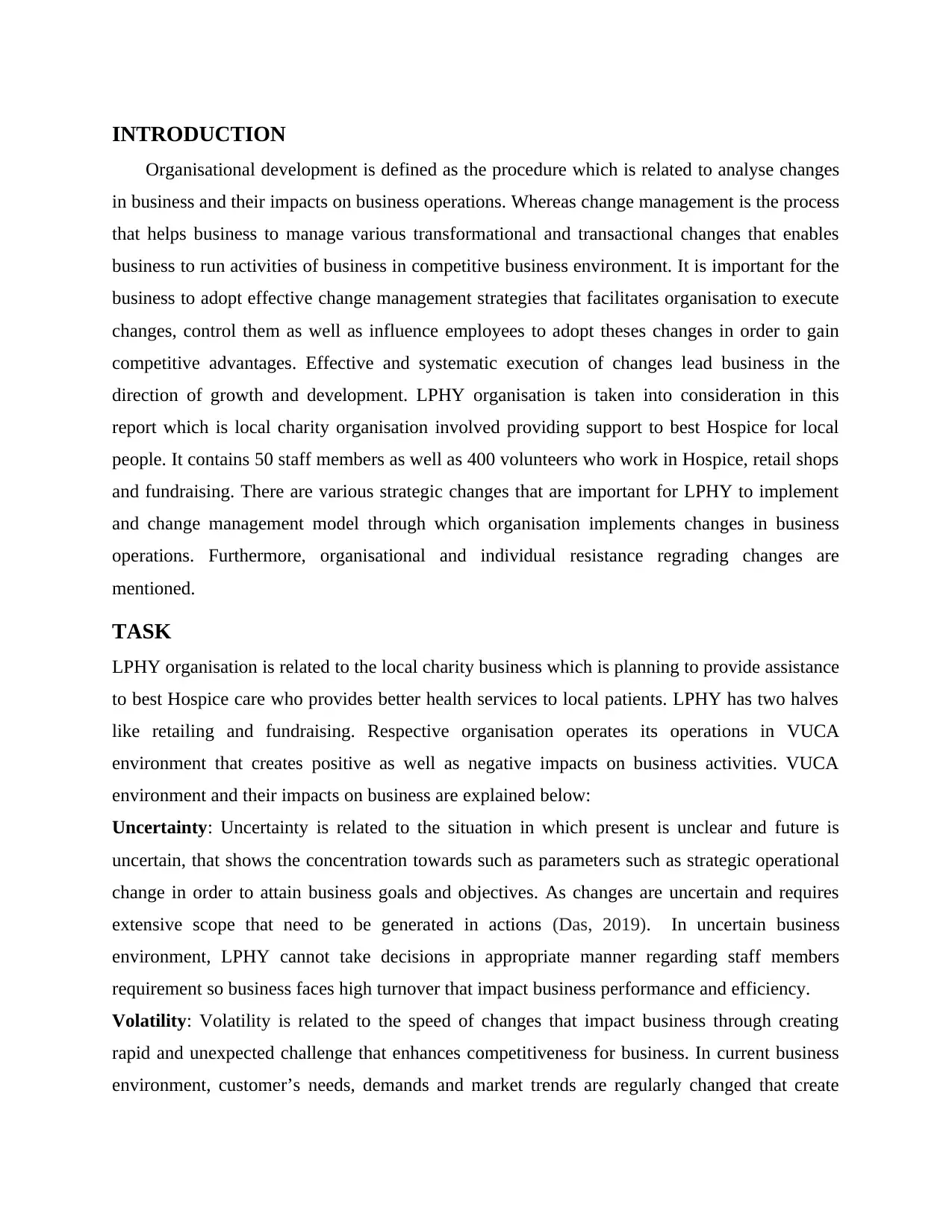
INTRODUCTION
Organisational development is defined as the procedure which is related to analyse changes
in business and their impacts on business operations. Whereas change management is the process
that helps business to manage various transformational and transactional changes that enables
business to run activities of business in competitive business environment. It is important for the
business to adopt effective change management strategies that facilitates organisation to execute
changes, control them as well as influence employees to adopt theses changes in order to gain
competitive advantages. Effective and systematic execution of changes lead business in the
direction of growth and development. LPHY organisation is taken into consideration in this
report which is local charity organisation involved providing support to best Hospice for local
people. It contains 50 staff members as well as 400 volunteers who work in Hospice, retail shops
and fundraising. There are various strategic changes that are important for LPHY to implement
and change management model through which organisation implements changes in business
operations. Furthermore, organisational and individual resistance regrading changes are
mentioned.
TASK
LPHY organisation is related to the local charity business which is planning to provide assistance
to best Hospice care who provides better health services to local patients. LPHY has two halves
like retailing and fundraising. Respective organisation operates its operations in VUCA
environment that creates positive as well as negative impacts on business activities. VUCA
environment and their impacts on business are explained below:
Uncertainty: Uncertainty is related to the situation in which present is unclear and future is
uncertain, that shows the concentration towards such as parameters such as strategic operational
change in order to attain business goals and objectives. As changes are uncertain and requires
extensive scope that need to be generated in actions (Das, 2019). In uncertain business
environment, LPHY cannot take decisions in appropriate manner regarding staff members
requirement so business faces high turnover that impact business performance and efficiency.
Volatility: Volatility is related to the speed of changes that impact business through creating
rapid and unexpected challenge that enhances competitiveness for business. In current business
environment, customer’s needs, demands and market trends are regularly changed that create
Organisational development is defined as the procedure which is related to analyse changes
in business and their impacts on business operations. Whereas change management is the process
that helps business to manage various transformational and transactional changes that enables
business to run activities of business in competitive business environment. It is important for the
business to adopt effective change management strategies that facilitates organisation to execute
changes, control them as well as influence employees to adopt theses changes in order to gain
competitive advantages. Effective and systematic execution of changes lead business in the
direction of growth and development. LPHY organisation is taken into consideration in this
report which is local charity organisation involved providing support to best Hospice for local
people. It contains 50 staff members as well as 400 volunteers who work in Hospice, retail shops
and fundraising. There are various strategic changes that are important for LPHY to implement
and change management model through which organisation implements changes in business
operations. Furthermore, organisational and individual resistance regrading changes are
mentioned.
TASK
LPHY organisation is related to the local charity business which is planning to provide assistance
to best Hospice care who provides better health services to local patients. LPHY has two halves
like retailing and fundraising. Respective organisation operates its operations in VUCA
environment that creates positive as well as negative impacts on business activities. VUCA
environment and their impacts on business are explained below:
Uncertainty: Uncertainty is related to the situation in which present is unclear and future is
uncertain, that shows the concentration towards such as parameters such as strategic operational
change in order to attain business goals and objectives. As changes are uncertain and requires
extensive scope that need to be generated in actions (Das, 2019). In uncertain business
environment, LPHY cannot take decisions in appropriate manner regarding staff members
requirement so business faces high turnover that impact business performance and efficiency.
Volatility: Volatility is related to the speed of changes that impact business through creating
rapid and unexpected challenge that enhances competitiveness for business. In current business
environment, customer’s needs, demands and market trends are regularly changed that create
⊘ This is a preview!⊘
Do you want full access?
Subscribe today to unlock all pages.

Trusted by 1+ million students worldwide
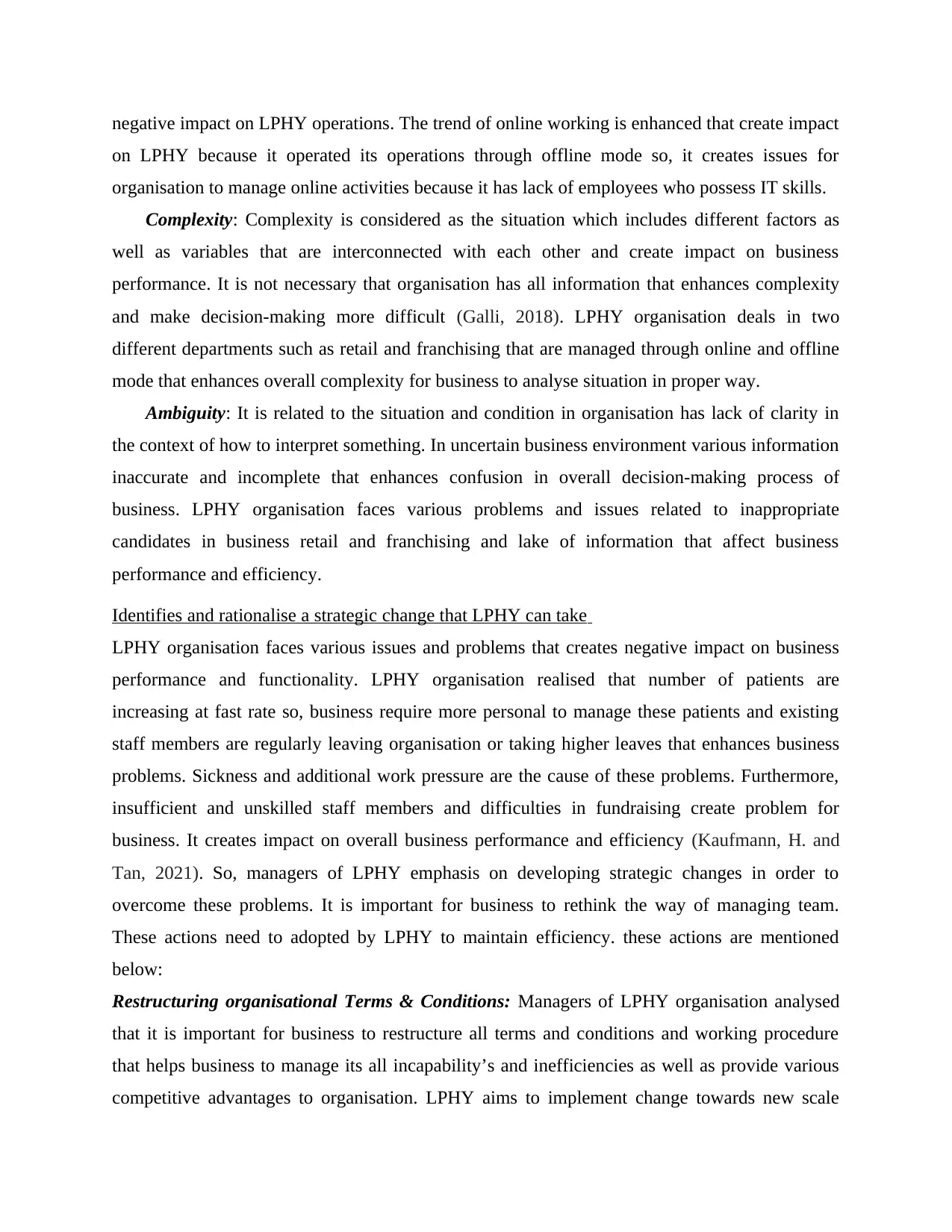
negative impact on LPHY operations. The trend of online working is enhanced that create impact
on LPHY because it operated its operations through offline mode so, it creates issues for
organisation to manage online activities because it has lack of employees who possess IT skills.
Complexity: Complexity is considered as the situation which includes different factors as
well as variables that are interconnected with each other and create impact on business
performance. It is not necessary that organisation has all information that enhances complexity
and make decision-making more difficult (Galli, 2018). LPHY organisation deals in two
different departments such as retail and franchising that are managed through online and offline
mode that enhances overall complexity for business to analyse situation in proper way.
Ambiguity: It is related to the situation and condition in organisation has lack of clarity in
the context of how to interpret something. In uncertain business environment various information
inaccurate and incomplete that enhances confusion in overall decision-making process of
business. LPHY organisation faces various problems and issues related to inappropriate
candidates in business retail and franchising and lake of information that affect business
performance and efficiency.
Identifies and rationalise a strategic change that LPHY can take
LPHY organisation faces various issues and problems that creates negative impact on business
performance and functionality. LPHY organisation realised that number of patients are
increasing at fast rate so, business require more personal to manage these patients and existing
staff members are regularly leaving organisation or taking higher leaves that enhances business
problems. Sickness and additional work pressure are the cause of these problems. Furthermore,
insufficient and unskilled staff members and difficulties in fundraising create problem for
business. It creates impact on overall business performance and efficiency (Kaufmann, H. and
Tan, 2021). So, managers of LPHY emphasis on developing strategic changes in order to
overcome these problems. It is important for business to rethink the way of managing team.
These actions need to adopted by LPHY to maintain efficiency. these actions are mentioned
below:
Restructuring organisational Terms & Conditions: Managers of LPHY organisation analysed
that it is important for business to restructure all terms and conditions and working procedure
that helps business to manage its all incapability’s and inefficiencies as well as provide various
competitive advantages to organisation. LPHY aims to implement change towards new scale
on LPHY because it operated its operations through offline mode so, it creates issues for
organisation to manage online activities because it has lack of employees who possess IT skills.
Complexity: Complexity is considered as the situation which includes different factors as
well as variables that are interconnected with each other and create impact on business
performance. It is not necessary that organisation has all information that enhances complexity
and make decision-making more difficult (Galli, 2018). LPHY organisation deals in two
different departments such as retail and franchising that are managed through online and offline
mode that enhances overall complexity for business to analyse situation in proper way.
Ambiguity: It is related to the situation and condition in organisation has lack of clarity in
the context of how to interpret something. In uncertain business environment various information
inaccurate and incomplete that enhances confusion in overall decision-making process of
business. LPHY organisation faces various problems and issues related to inappropriate
candidates in business retail and franchising and lake of information that affect business
performance and efficiency.
Identifies and rationalise a strategic change that LPHY can take
LPHY organisation faces various issues and problems that creates negative impact on business
performance and functionality. LPHY organisation realised that number of patients are
increasing at fast rate so, business require more personal to manage these patients and existing
staff members are regularly leaving organisation or taking higher leaves that enhances business
problems. Sickness and additional work pressure are the cause of these problems. Furthermore,
insufficient and unskilled staff members and difficulties in fundraising create problem for
business. It creates impact on overall business performance and efficiency (Kaufmann, H. and
Tan, 2021). So, managers of LPHY emphasis on developing strategic changes in order to
overcome these problems. It is important for business to rethink the way of managing team.
These actions need to adopted by LPHY to maintain efficiency. these actions are mentioned
below:
Restructuring organisational Terms & Conditions: Managers of LPHY organisation analysed
that it is important for business to restructure all terms and conditions and working procedure
that helps business to manage its all incapability’s and inefficiencies as well as provide various
competitive advantages to organisation. LPHY aims to implement change towards new scale
Paraphrase This Document
Need a fresh take? Get an instant paraphrase of this document with our AI Paraphraser
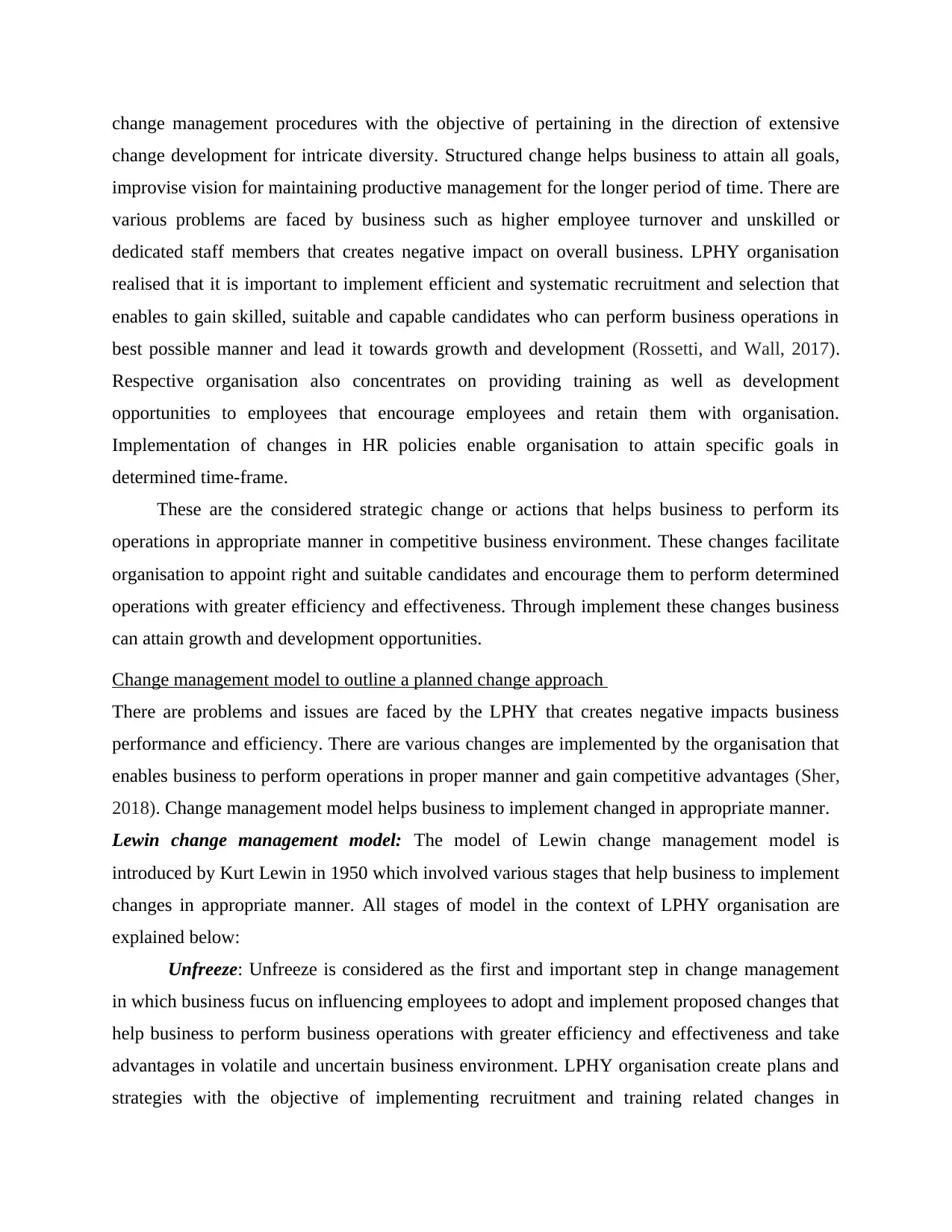
change management procedures with the objective of pertaining in the direction of extensive
change development for intricate diversity. Structured change helps business to attain all goals,
improvise vision for maintaining productive management for the longer period of time. There are
various problems are faced by business such as higher employee turnover and unskilled or
dedicated staff members that creates negative impact on overall business. LPHY organisation
realised that it is important to implement efficient and systematic recruitment and selection that
enables to gain skilled, suitable and capable candidates who can perform business operations in
best possible manner and lead it towards growth and development (Rossetti, and Wall, 2017).
Respective organisation also concentrates on providing training as well as development
opportunities to employees that encourage employees and retain them with organisation.
Implementation of changes in HR policies enable organisation to attain specific goals in
determined time-frame.
These are the considered strategic change or actions that helps business to perform its
operations in appropriate manner in competitive business environment. These changes facilitate
organisation to appoint right and suitable candidates and encourage them to perform determined
operations with greater efficiency and effectiveness. Through implement these changes business
can attain growth and development opportunities.
Change management model to outline a planned change approach
There are problems and issues are faced by the LPHY that creates negative impacts business
performance and efficiency. There are various changes are implemented by the organisation that
enables business to perform operations in proper manner and gain competitive advantages (Sher,
2018). Change management model helps business to implement changed in appropriate manner.
Lewin change management model: The model of Lewin change management model is
introduced by Kurt Lewin in 1950 which involved various stages that help business to implement
changes in appropriate manner. All stages of model in the context of LPHY organisation are
explained below:
Unfreeze: Unfreeze is considered as the first and important step in change management
in which business fucus on influencing employees to adopt and implement proposed changes that
help business to perform business operations with greater efficiency and effectiveness and take
advantages in volatile and uncertain business environment. LPHY organisation create plans and
strategies with the objective of implementing recruitment and training related changes in
change development for intricate diversity. Structured change helps business to attain all goals,
improvise vision for maintaining productive management for the longer period of time. There are
various problems are faced by business such as higher employee turnover and unskilled or
dedicated staff members that creates negative impact on overall business. LPHY organisation
realised that it is important to implement efficient and systematic recruitment and selection that
enables to gain skilled, suitable and capable candidates who can perform business operations in
best possible manner and lead it towards growth and development (Rossetti, and Wall, 2017).
Respective organisation also concentrates on providing training as well as development
opportunities to employees that encourage employees and retain them with organisation.
Implementation of changes in HR policies enable organisation to attain specific goals in
determined time-frame.
These are the considered strategic change or actions that helps business to perform its
operations in appropriate manner in competitive business environment. These changes facilitate
organisation to appoint right and suitable candidates and encourage them to perform determined
operations with greater efficiency and effectiveness. Through implement these changes business
can attain growth and development opportunities.
Change management model to outline a planned change approach
There are problems and issues are faced by the LPHY that creates negative impacts business
performance and efficiency. There are various changes are implemented by the organisation that
enables business to perform operations in proper manner and gain competitive advantages (Sher,
2018). Change management model helps business to implement changed in appropriate manner.
Lewin change management model: The model of Lewin change management model is
introduced by Kurt Lewin in 1950 which involved various stages that help business to implement
changes in appropriate manner. All stages of model in the context of LPHY organisation are
explained below:
Unfreeze: Unfreeze is considered as the first and important step in change management
in which business fucus on influencing employees to adopt and implement proposed changes that
help business to perform business operations with greater efficiency and effectiveness and take
advantages in volatile and uncertain business environment. LPHY organisation create plans and
strategies with the objective of implementing recruitment and training related changes in
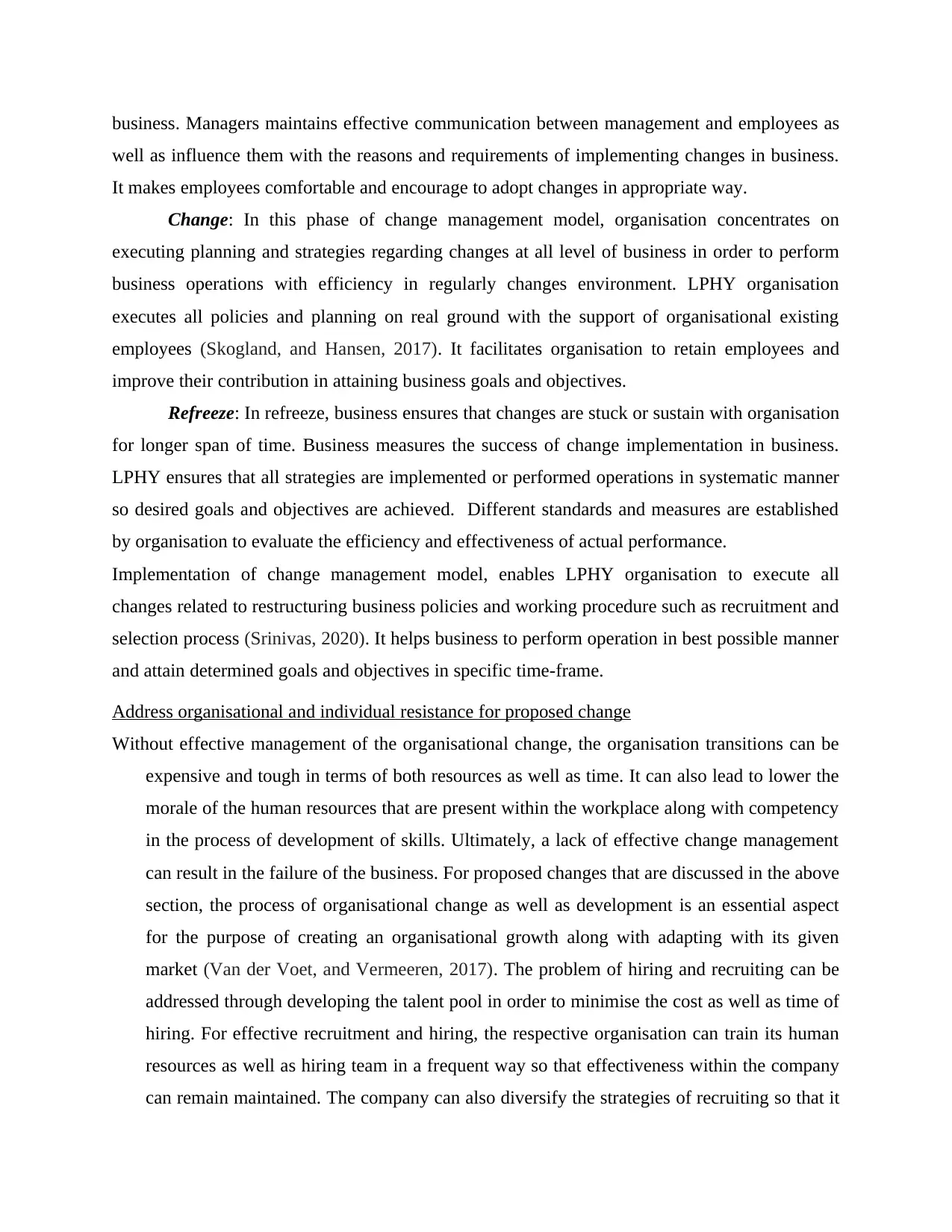
business. Managers maintains effective communication between management and employees as
well as influence them with the reasons and requirements of implementing changes in business.
It makes employees comfortable and encourage to adopt changes in appropriate way.
Change: In this phase of change management model, organisation concentrates on
executing planning and strategies regarding changes at all level of business in order to perform
business operations with efficiency in regularly changes environment. LPHY organisation
executes all policies and planning on real ground with the support of organisational existing
employees (Skogland, and Hansen, 2017). It facilitates organisation to retain employees and
improve their contribution in attaining business goals and objectives.
Refreeze: In refreeze, business ensures that changes are stuck or sustain with organisation
for longer span of time. Business measures the success of change implementation in business.
LPHY ensures that all strategies are implemented or performed operations in systematic manner
so desired goals and objectives are achieved. Different standards and measures are established
by organisation to evaluate the efficiency and effectiveness of actual performance.
Implementation of change management model, enables LPHY organisation to execute all
changes related to restructuring business policies and working procedure such as recruitment and
selection process (Srinivas, 2020). It helps business to perform operation in best possible manner
and attain determined goals and objectives in specific time-frame.
Address organisational and individual resistance for proposed change
Without effective management of the organisational change, the organisation transitions can be
expensive and tough in terms of both resources as well as time. It can also lead to lower the
morale of the human resources that are present within the workplace along with competency
in the process of development of skills. Ultimately, a lack of effective change management
can result in the failure of the business. For proposed changes that are discussed in the above
section, the process of organisational change as well as development is an essential aspect
for the purpose of creating an organisational growth along with adapting with its given
market (Van der Voet, and Vermeeren, 2017). The problem of hiring and recruiting can be
addressed through developing the talent pool in order to minimise the cost as well as time of
hiring. For effective recruitment and hiring, the respective organisation can train its human
resources as well as hiring team in a frequent way so that effectiveness within the company
can remain maintained. The company can also diversify the strategies of recruiting so that it
well as influence them with the reasons and requirements of implementing changes in business.
It makes employees comfortable and encourage to adopt changes in appropriate way.
Change: In this phase of change management model, organisation concentrates on
executing planning and strategies regarding changes at all level of business in order to perform
business operations with efficiency in regularly changes environment. LPHY organisation
executes all policies and planning on real ground with the support of organisational existing
employees (Skogland, and Hansen, 2017). It facilitates organisation to retain employees and
improve their contribution in attaining business goals and objectives.
Refreeze: In refreeze, business ensures that changes are stuck or sustain with organisation
for longer span of time. Business measures the success of change implementation in business.
LPHY ensures that all strategies are implemented or performed operations in systematic manner
so desired goals and objectives are achieved. Different standards and measures are established
by organisation to evaluate the efficiency and effectiveness of actual performance.
Implementation of change management model, enables LPHY organisation to execute all
changes related to restructuring business policies and working procedure such as recruitment and
selection process (Srinivas, 2020). It helps business to perform operation in best possible manner
and attain determined goals and objectives in specific time-frame.
Address organisational and individual resistance for proposed change
Without effective management of the organisational change, the organisation transitions can be
expensive and tough in terms of both resources as well as time. It can also lead to lower the
morale of the human resources that are present within the workplace along with competency
in the process of development of skills. Ultimately, a lack of effective change management
can result in the failure of the business. For proposed changes that are discussed in the above
section, the process of organisational change as well as development is an essential aspect
for the purpose of creating an organisational growth along with adapting with its given
market (Van der Voet, and Vermeeren, 2017). The problem of hiring and recruiting can be
addressed through developing the talent pool in order to minimise the cost as well as time of
hiring. For effective recruitment and hiring, the respective organisation can train its human
resources as well as hiring team in a frequent way so that effectiveness within the company
can remain maintained. The company can also diversify the strategies of recruiting so that it
⊘ This is a preview!⊘
Do you want full access?
Subscribe today to unlock all pages.

Trusted by 1+ million students worldwide
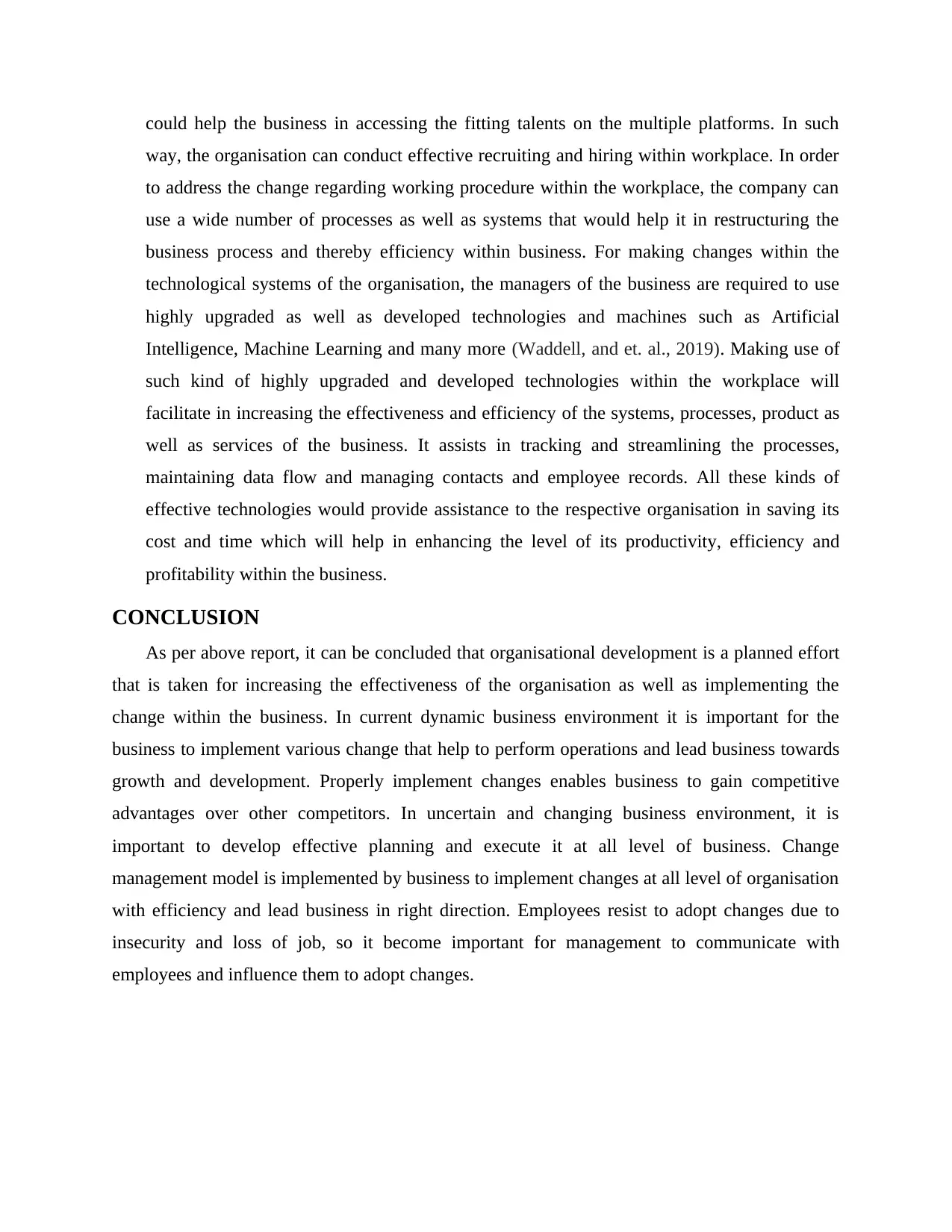
could help the business in accessing the fitting talents on the multiple platforms. In such
way, the organisation can conduct effective recruiting and hiring within workplace. In order
to address the change regarding working procedure within the workplace, the company can
use a wide number of processes as well as systems that would help it in restructuring the
business process and thereby efficiency within business. For making changes within the
technological systems of the organisation, the managers of the business are required to use
highly upgraded as well as developed technologies and machines such as Artificial
Intelligence, Machine Learning and many more (Waddell, and et. al., 2019). Making use of
such kind of highly upgraded and developed technologies within the workplace will
facilitate in increasing the effectiveness and efficiency of the systems, processes, product as
well as services of the business. It assists in tracking and streamlining the processes,
maintaining data flow and managing contacts and employee records. All these kinds of
effective technologies would provide assistance to the respective organisation in saving its
cost and time which will help in enhancing the level of its productivity, efficiency and
profitability within the business.
CONCLUSION
As per above report, it can be concluded that organisational development is a planned effort
that is taken for increasing the effectiveness of the organisation as well as implementing the
change within the business. In current dynamic business environment it is important for the
business to implement various change that help to perform operations and lead business towards
growth and development. Properly implement changes enables business to gain competitive
advantages over other competitors. In uncertain and changing business environment, it is
important to develop effective planning and execute it at all level of business. Change
management model is implemented by business to implement changes at all level of organisation
with efficiency and lead business in right direction. Employees resist to adopt changes due to
insecurity and loss of job, so it become important for management to communicate with
employees and influence them to adopt changes.
way, the organisation can conduct effective recruiting and hiring within workplace. In order
to address the change regarding working procedure within the workplace, the company can
use a wide number of processes as well as systems that would help it in restructuring the
business process and thereby efficiency within business. For making changes within the
technological systems of the organisation, the managers of the business are required to use
highly upgraded as well as developed technologies and machines such as Artificial
Intelligence, Machine Learning and many more (Waddell, and et. al., 2019). Making use of
such kind of highly upgraded and developed technologies within the workplace will
facilitate in increasing the effectiveness and efficiency of the systems, processes, product as
well as services of the business. It assists in tracking and streamlining the processes,
maintaining data flow and managing contacts and employee records. All these kinds of
effective technologies would provide assistance to the respective organisation in saving its
cost and time which will help in enhancing the level of its productivity, efficiency and
profitability within the business.
CONCLUSION
As per above report, it can be concluded that organisational development is a planned effort
that is taken for increasing the effectiveness of the organisation as well as implementing the
change within the business. In current dynamic business environment it is important for the
business to implement various change that help to perform operations and lead business towards
growth and development. Properly implement changes enables business to gain competitive
advantages over other competitors. In uncertain and changing business environment, it is
important to develop effective planning and execute it at all level of business. Change
management model is implemented by business to implement changes at all level of organisation
with efficiency and lead business in right direction. Employees resist to adopt changes due to
insecurity and loss of job, so it become important for management to communicate with
employees and influence them to adopt changes.
Paraphrase This Document
Need a fresh take? Get an instant paraphrase of this document with our AI Paraphraser

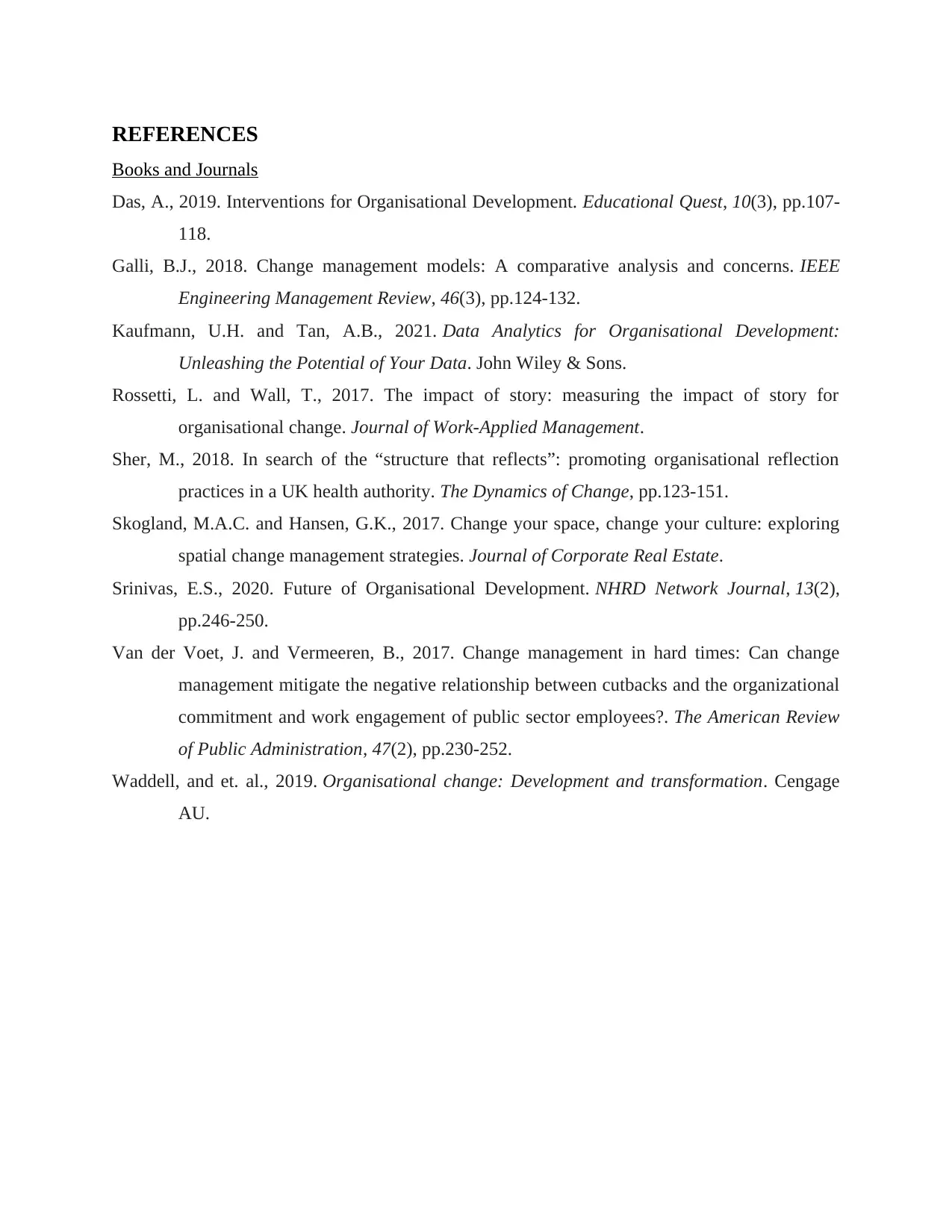
REFERENCES
Books and Journals
Das, A., 2019. Interventions for Organisational Development. Educational Quest, 10(3), pp.107-
118.
Galli, B.J., 2018. Change management models: A comparative analysis and concerns. IEEE
Engineering Management Review, 46(3), pp.124-132.
Kaufmann, U.H. and Tan, A.B., 2021. Data Analytics for Organisational Development:
Unleashing the Potential of Your Data. John Wiley & Sons.
Rossetti, L. and Wall, T., 2017. The impact of story: measuring the impact of story for
organisational change. Journal of Work-Applied Management.
Sher, M., 2018. In search of the “structure that reflects”: promoting organisational reflection
practices in a UK health authority. The Dynamics of Change, pp.123-151.
Skogland, M.A.C. and Hansen, G.K., 2017. Change your space, change your culture: exploring
spatial change management strategies. Journal of Corporate Real Estate.
Srinivas, E.S., 2020. Future of Organisational Development. NHRD Network Journal, 13(2),
pp.246-250.
Van der Voet, J. and Vermeeren, B., 2017. Change management in hard times: Can change
management mitigate the negative relationship between cutbacks and the organizational
commitment and work engagement of public sector employees?. The American Review
of Public Administration, 47(2), pp.230-252.
Waddell, and et. al., 2019. Organisational change: Development and transformation. Cengage
AU.
Books and Journals
Das, A., 2019. Interventions for Organisational Development. Educational Quest, 10(3), pp.107-
118.
Galli, B.J., 2018. Change management models: A comparative analysis and concerns. IEEE
Engineering Management Review, 46(3), pp.124-132.
Kaufmann, U.H. and Tan, A.B., 2021. Data Analytics for Organisational Development:
Unleashing the Potential of Your Data. John Wiley & Sons.
Rossetti, L. and Wall, T., 2017. The impact of story: measuring the impact of story for
organisational change. Journal of Work-Applied Management.
Sher, M., 2018. In search of the “structure that reflects”: promoting organisational reflection
practices in a UK health authority. The Dynamics of Change, pp.123-151.
Skogland, M.A.C. and Hansen, G.K., 2017. Change your space, change your culture: exploring
spatial change management strategies. Journal of Corporate Real Estate.
Srinivas, E.S., 2020. Future of Organisational Development. NHRD Network Journal, 13(2),
pp.246-250.
Van der Voet, J. and Vermeeren, B., 2017. Change management in hard times: Can change
management mitigate the negative relationship between cutbacks and the organizational
commitment and work engagement of public sector employees?. The American Review
of Public Administration, 47(2), pp.230-252.
Waddell, and et. al., 2019. Organisational change: Development and transformation. Cengage
AU.
⊘ This is a preview!⊘
Do you want full access?
Subscribe today to unlock all pages.

Trusted by 1+ million students worldwide

1 out of 10
Related Documents
Your All-in-One AI-Powered Toolkit for Academic Success.
+13062052269
info@desklib.com
Available 24*7 on WhatsApp / Email
![[object Object]](/_next/static/media/star-bottom.7253800d.svg)
Unlock your academic potential
Copyright © 2020–2025 A2Z Services. All Rights Reserved. Developed and managed by ZUCOL.
